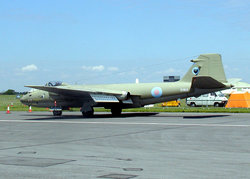Surveillance aircraft
|
|
A military aircraft used for monitoring enemy activity, usually carrying no armament. This article concentrates on military aircraft used in this role, though a major civilian aviation activity is reconnaissance and ground surveillance for mapping, traffic monitoring, science, and geological survey. In addition, civilian aircraft are used in many countries for border surveillance, fishery patrols or the prevention of smuggling and illegal migration.
Such efforts long predate the invention of heavier-than-air flight, with experiments using balloons to provide targeting information for artillery beginning in France in 1794, though continued attempts throughout the 19th Century proved militarily useless.
History
One of the first aircraft used for surveillance was the Rumpler Taube during World War I. The translucent wings of the plane made it very difficult for ground based observers to detect a Taube at an altitude above 400m. The French called this plane also "the Invisible Aircraft", and it is sometimes also referred to as the "world's very first stealth plane". German Taube airplanes were able to detect the advancing Russian army during the Battle of Tannenberg (1914).
During World War II, fighters such as the British Spitfire and Mosquito were adapted for photo-reconnaissance. Such craft were stripped of weaponry, painted in sky camoflague colours to make them difficult to spot in the air, and often had engines modified for higher performance at very high altitudes (well over 40,000 feet). Early in the war, the British developed a warming system to allow photographs to be taken at very high altitudes. The collection and interpretation of such photographs became a considerable enterprise. One site (http://www.nzfpm.co.nz/theatres/tow_prec.htm) claims that the British, at their peak, flew over 100 reconnaissance flights a day, yielding 50,000 images per day to interpret. Similar efforts were taken by other countries.
In the 1950s, the first purpose-built jet covert surveillance aircraft, the Lockheed U-2 was constructed secretly for the United States. Designed for flights over Soviet territory, the plane remained an obscurity until one piloted by Gary Powers was shot down over the Soviet Union in 1960, leading to the U-2 Crisis. Modified versions of the U-2 remain in service in 2002, though its capabilities and operations remain secret. In the 1960s, the SR-71 Blackbird, the fastest manned jet-propelled aircraft ever built, was constructed. However, as both the United States and Soviet Union possessed surveillance satellites, interest in new types of photo-reconnaissance aircraft declined. Another 1950s design, the English Electric Canberra continues to serve the RAF in the same role. Other famous reconnaissance types include the Avro Shackleton and, also from Lockheed, the Neptune and Orion. The latter type became famous when a Chinese interceptor collided with the wing of a US Navy example patrolling international waters. The crew of the larger US aircraft made an emergency landing but the fighter crashed killing its pilot. The Orion was impounded by the Chinese authorities and closely inspected before it was dismantled and returned to the USA. The crew were questioned but released prior to the aircraft's return.
Current use
Several unmanned remotely-controlled reconnaissance aircraft (UAVs) have been recently deployed or are under development in many countries, including Israel, the United States and South Africa. Currently under development are, amongst others, the RQ-4 Global Hawk, a high-altitude jet-propelled craft that resembles the U-2, and the smaller, medium-altitude RQ-1 Predator. Schweizer are developing remotely-piloted versions of a light helicopter.
Most Air Forces around the world lack dedicated surveillance planes, but have the capability of adding reconnaissance cameras to combat and transport aircraft.
Another type of surveillance aircraft is the electronic surveillance aircraft. Whilst other military aircraft, including photo-reconnaissance aircraft, have been used for that purpose, several countries adapt aircraft for electronic intelligence gathering. The Beech RC-12 Super King Air, Boeing RC-135 Rivet Joint and BAe Nimrod R1 are examples of this military activity, which helps to reduce opportunities for surprise attack or the risks of training exercises being misunderstood by potential enemies.
As well as the development of UAVs, another recent trend in surveillance aircraft design has been the realization that, with the addition of lightweight sensors and communications gear, every fighter plane and ground attack plane can simultaneously be used to perform surveillance. Hence, the in-development F-35 multirole fighter plane will have extensive surveillance and communications capabilities built in .
See also
- AWACS
- Treaty on Open Skies
- spyflight (http://www.spyflight.co.uk)de:Aufklärungsflugzeug

